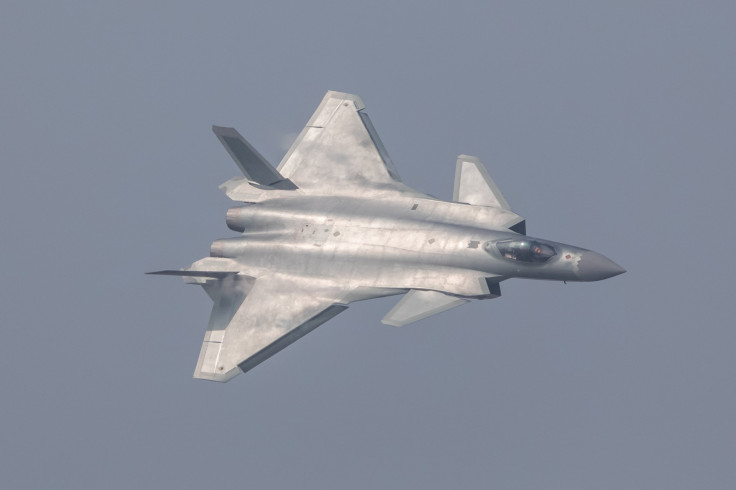Intriguing Image Of Tailless Fighter Offers Peek Into China's Future Ambitions
KEY POINTS
- Despite the lack of official information, the fact that China is working on its sixth-generation fighter jet is not a secret
- A similar-looking fighter airframe was seen in satellite images of a Chengdu Aircraft Corporation factory airfield in October 2021
- Beijing is believed to be developing a fighter similar to the U.S. Air Force's Next Generation Air Dominance program
An intriguing image appearing on social media has set in motion speculation about the progress in China's efforts to develop sixth-generation fighter jets while offering a peek into Beijing's future ambitions.
Although the legitimacy of the photo remains unconfirmed, the evidence hinted that, at least, the design concept is being closely studied and that China may indeed be focusing efforts to build its sixth-generation fighter jets based on a tailless configuration, the War Zone said in a report Wednesday.
The image, which reportedly first appeared on the Chinese microblogging website Weibo, offered no clue about what it was or where the picture was taken. However, Chinese aerospace observer and author Andreas Rupprecht, who shared the image on Twitter, said the tailless diamond wing design could be a "mockup" or "technology demonstrator" of China's sixth-generation fighter being built by 611 Institute/CAC.
Known since October 2021 on satellite images, this is suggested to be a (full) ? scale mockup or even a 6. generation technology demonstrator built by 611 Institute/CAC featuring a tailless diamond wing configuration.
— @Rupprecht_A (@RupprechtDeino) January 18, 2023
And today this ... Just a CG or indeed the rumoured testbed? pic.twitter.com/7TgbApYBDz
Based on a visual evaluation of the image, the War Zone report assessed that it seemed to be a simulation to investigate or demonstrate the characteristics of a tailless fighter concept or its subsystems.
Significantly, on a closer look, the emblem of the Aviation Industry Corporation of China (AVIC) can be seen in the background on the dome simulator, as highlighted by the report.
AVIC is a diversified state-owned aerospace and defense company headquartered in Beijing. Its divisions are involved in aircraft and helicopter manufacturing, avionics, engine components and military aviation and defense systems.
Based on the accompanying Chinese text states, the report suggested that the image is of an ergonomics design and evaluation lab, indicating that the assumed simulation activity concerns the development of future fighter cockpits and interface features, rather than the design of a tailless aircraft.
Considering an indication that the photo shows the interior of the China Aeronautical Radio Electronics Research Institute based in Shanghai, the War Zone report added that the facility may be working alongside AVIC on some aspect of China's future fighter program.
This is China Aeronautical Radio Electronics Research Institute(its located in Shanghai)中国航空无线电电子研究所, They may just be working on some of the aircraft's systems. pic.twitter.com/PaZxILyicr
— 长堤轻语 (@xiagurouqingzh1) January 18, 2023
Although much of the details about the kinds of simulations or evaluations being carried out, as seen in the photo, is informed speculation, the War Zone report stressed that a tailless and delta-like wing design is being considered a top configuration for China's next-generation fighter aircraft.
A very similar-looking still-mysterious fighter airframe was seen in satellite images of a Chengdu Aircraft Corporation (CAC) factory airfield in October 2021, about which the War Zone reported that same month. A subsidiary of AVIC, CAC is one of China's two preeminent fighter manufacturers and the top candidate to develop the sixth-generation fighter jets of the People's Liberation Army (PLA).
The model seen in satellite images of a CAC factory airfield appeared to be a large modified diamond-like delta planform having a thin nose section along with a wingspan roughly the size of the Chinese J-20 fighter jet.
While unofficial artworks depicting concepts for tailless combat aircraft have become more common in the country, Chinese academic papers have also been looking at the concept closely, indicating a growing interest in the design, as per the report.
Compared to the jets currently operated by the country, a tailless design will reportedly offer China significant advances, all of which could prove critical in the Asia Pacific theater, including stealth, speed and payload capacity.
Zhuhai Air Show 🇨🇳
— David Wang (@Nickatgreat1220) November 6, 2022
6th Gen Fighter Aircraft Concept
PLAAF Loves Tailless Jet Design pic.twitter.com/hyTPqZlHGT
Despite the lack of official information, the fact that China is working on its sixth-generation fighter jet is not a secret. In September 2022, Gen. Mark D. Kelly, the head of Air Combat Command (ACC), confirmed that Beijing was developing a fighter similar to the U.S. Air Force's Next Generation Air Dominance program or the NGAD.
The U.S. Air Force plans to use the NGAD to replace the F-22 fighter jet beginning in 2030 to include a combination of crewed and uncrewed aircraft. Meanwhile, as the War Zone report pointed out, Beijing may be looking at a similar timeframe for its sixth-generation fighter jet program to work with supporting technologies brought together as part of China's broader future air combat architecture that includes drones, artificial intelligence and advanced sensors.

© Copyright IBTimes 2024. All rights reserved.




















